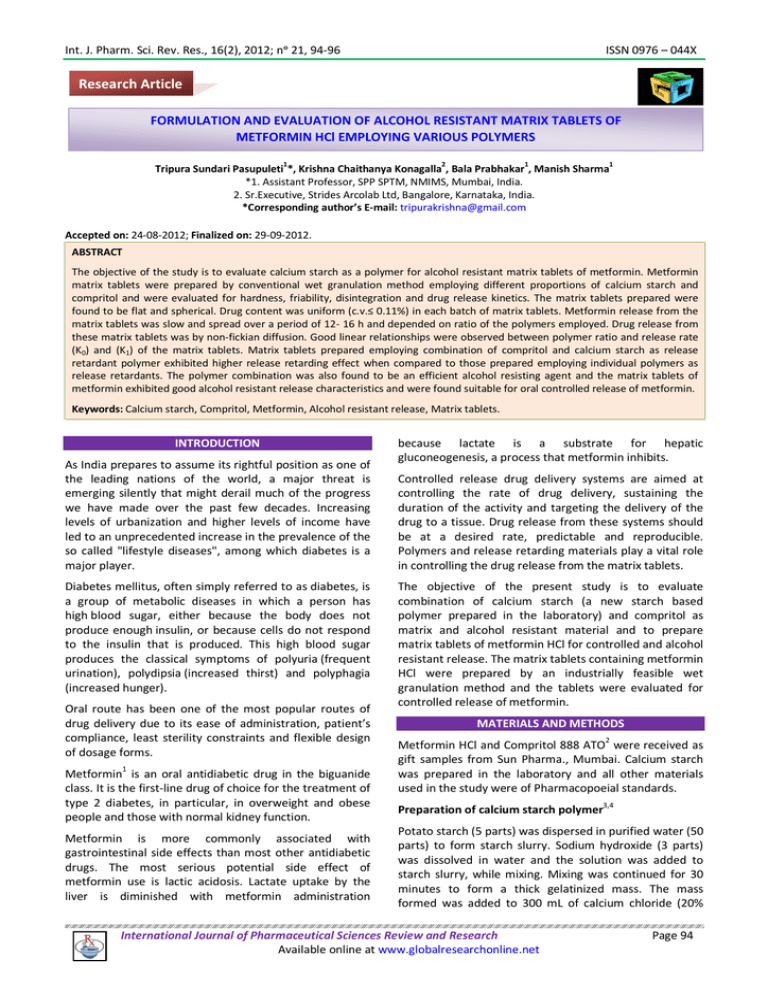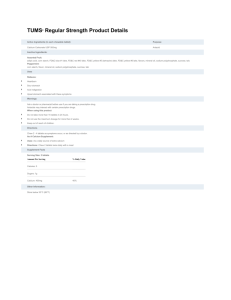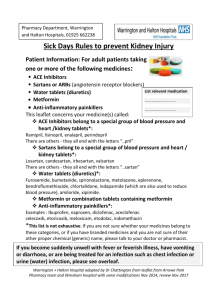Document 13308901
advertisement

Int. J. Pharm. Sci. Rev. Res., 16(2), 2012; nᵒ 21, 94-96 ISSN 0976 – 044X Research Article FORMULATION AND EVALUATION OF ALCOHOL RESISTANT MATRIX TABLETS OF METFORMIN HCl EMPLOYING VARIOUS POLYMERS 1 2 1 1 Tripura Sundari Pasupuleti *, Krishna Chaithanya Konagalla , Bala Prabhakar , Manish Sharma *1. Assistant Professor, SPP SPTM, NMIMS, Mumbai, India. 2. Sr.Executive, Strides Arcolab Ltd, Bangalore, Karnataka, India. *Corresponding author’s E-mail: tripurakrishna@gmail.com Accepted on: 24-08-2012; Finalized on: 29-09-2012. ABSTRACT The objective of the study is to evaluate calcium starch as a polymer for alcohol resistant matrix tablets of metformin. Metformin matrix tablets were prepared by conventional wet granulation method employing different proportions of calcium starch and compritol and were evaluated for hardness, friability, disintegration and drug release kinetics. The matrix tablets prepared were found to be flat and spherical. Drug content was uniform (c.v.≤ 0.11%) in each batch of matrix tablets. Metformin release from the matrix tablets was slow and spread over a period of 12- 16 h and depended on ratio of the polymers employed. Drug release from these matrix tablets was by non-fickian diffusion. Good linear relationships were observed between polymer ratio and release rate (K0) and (K1) of the matrix tablets. Matrix tablets prepared employing combination of compritol and calcium starch as release retardant polymer exhibited higher release retarding effect when compared to those prepared employing individual polymers as release retardants. The polymer combination was also found to be an efficient alcohol resisting agent and the matrix tablets of metformin exhibited good alcohol resistant release characteristics and were found suitable for oral controlled release of metformin. Keywords: Calcium starch, Compritol, Metformin, Alcohol resistant release, Matrix tablets. INTRODUCTION As India prepares to assume its rightful position as one of the leading nations of the world, a major threat is emerging silently that might derail much of the progress we have made over the past few decades. Increasing levels of urbanization and higher levels of income have led to an unprecedented increase in the prevalence of the so called "lifestyle diseases", among which diabetes is a major player. Diabetes mellitus, often simply referred to as diabetes, is a group of metabolic diseases in which a person has high blood sugar, either because the body does not produce enough insulin, or because cells do not respond to the insulin that is produced. This high blood sugar produces the classical symptoms of polyuria (frequent urination), polydipsia (increased thirst) and polyphagia (increased hunger). Oral route has been one of the most popular routes of drug delivery due to its ease of administration, patient’s compliance, least sterility constraints and flexible design of dosage forms. 1 Metformin is an oral antidiabetic drug in the biguanide class. It is the first-line drug of choice for the treatment of type 2 diabetes, in particular, in overweight and obese people and those with normal kidney function. Metformin is more commonly associated with gastrointestinal side effects than most other antidiabetic drugs. The most serious potential side effect of metformin use is lactic acidosis. Lactate uptake by the liver is diminished with metformin administration because lactate is a substrate for hepatic gluconeogenesis, a process that metformin inhibits. Controlled release drug delivery systems are aimed at controlling the rate of drug delivery, sustaining the duration of the activity and targeting the delivery of the drug to a tissue. Drug release from these systems should be at a desired rate, predictable and reproducible. Polymers and release retarding materials play a vital role in controlling the drug release from the matrix tablets. The objective of the present study is to evaluate combination of calcium starch (a new starch based polymer prepared in the laboratory) and compritol as matrix and alcohol resistant material and to prepare matrix tablets of metformin HCl for controlled and alcohol resistant release. The matrix tablets containing metformin HCl were prepared by an industrially feasible wet granulation method and the tablets were evaluated for controlled release of metformin. MATERIALS AND METHODS Metformin HCl and Compritol 888 ATO2 were received as gift samples from Sun Pharma., Mumbai. Calcium starch was prepared in the laboratory and all other materials used in the study were of Pharmacopoeial standards. 3,4 Preparation of calcium starch polymer Potato starch (5 parts) was dispersed in purified water (50 parts) to form starch slurry. Sodium hydroxide (3 parts) was dissolved in water and the solution was added to starch slurry, while mixing. Mixing was continued for 30 minutes to form a thick gelatinized mass. The mass formed was added to 300 mL of calcium chloride (20% International Journal of Pharmaceutical Sciences Review and Research Available online at www.globalresearchonline.net Page 94 Int. J. Pharm. Sci. Rev. Res., 16(2), 2012; nᵒ 21, 94-96 w/v) solution contained in a vessel while stirring at 100 rpm with a medium duty stirrer. The stirring was continued for 1 hour to precipitate calcium starch formed. The calcium starch formed was collected by vacuum filtration, washed repeatedly with water and dried at 80ᵒC. The dried polymer was powdered and passed through mesh No. 100. Preparation of Matrix tablets Matrix tablets each containing 500 mg of metformin HCl were prepared by conventional wet granulation method employing calcium starch and compritol5,6 in different proportions of drug and polymer. The required quantities of medicament and matrix materials were mixed thoroughly in a mortar by following geometric dilution technique. The binder solution (mixture of isopropyl alcohol and purified water at 1:1 ratio) was added and mixed thoroughly to form dough mass. The mass was shifted through sieve no. 10 to obtain wet granules. The granules were dried in hot air oven at 60ᵒC for 4 hours. The dried granules were again passed through sieve no. 18 to break aggregates. The lubricants talc and magnesium stearate which are pre sifted through mesh No. 100 were added and mixed in a poly bag for 5 minutes. The lubricated granules were compressed using 12-station rotary tablet machine (Rimek Minipress-11M, India) to produce metformin 500 mg tablets using flat punches of 13 mm diameter. Hardness of tablets was tested using a Monsanto hardness tester. Friability of tablets was determined in a Vegee friabilator. Disintegration time was determined in Tab machines TD-2 tablet disintegration test machine using water, 0.1 N HCl and phosphate buffer of pH 6.8 as test fluids. Estimation of metformin Metformin content of the tablets was determined by UV spectrophotometric method based on the measurement of absorbance at 233 nm in phosphate buffer of pH 6.8, the method was validated for linearity, precision and accuracy. The method obeyed Beer’s law in the concentration range 0-10 µg/mL. When a standard drug solution was assayed repeatedly (n=6), the mean error (accuracy) and relative standard deviation (precision) were found to be 0.6 and 0.8% respectively. No interference from the excipients used was observed. Drug release study Drug release from matrix tablets was studied using 8 station dissolution rate test apparatus (Lab India, Disso 2000) employing a paddle stirrer at 50 rpm and at 37±1ᵒC. phosphate buffer of pH 6.8 (900mL) was used as dissolution fluid. Samples of 5mL each were withdrawn at different time intervals over a period of 6 h. each sample withdrawn was replaced with an equal amount of fresh dissolution medium. Samples were suitably diluted and assayed at 233 nm for metformin using a shimadzu UV150 double beam UV spectrophotometer. For comparison, metformin release from glycomet SR and ISSN 0976 – 044X cetapin SR tablets were also studied. The drug release experiments were conducted in triplicate. Drug analysis Release data were analysed as per zero order and first order models to assess the drug release kinetics. RESULTS AND DISCUSSION Calcium starch was synthesized by gelatinizing potato starch in the presence of sodium hydroxide and cross linking by treatment with calcium chloride. The calcium starch polymer formed was found to be fine and free flowing powder upon drying. It was insoluble in water, aqueous fluids of acidic and alkaline pHs. When tested for melting point, the polymer was charred at 220ᵒC. Controlled release Matrix tablets each containing 500 mg of metformin were prepared employing different proportions (10, 20, 30 and 40% strengths in the formulae) of compritol, 40% of calcium starch as given in table 1 and various combinations of calcium starch and compritol (1:1, 1:2, 1:3 and 1:4) as given in table 2 by conventional wet granulation method. Hardness of the tablets was in the range of 6 – 8 Kg/sq. cm. Weight loss in the friability test was less than 0.3 % in all the cases. All the matrix tablets prepared containing metformin were found to be non – disintegrating in water and aqueous, acidic (pH 1.2) and alkaline (pH 7.4) fluids. As the tablets formulated employing compritol, calcium starch were non – disintegrating with acidic and alkaline fluids, they are considered suitable for oral controlled release. All matrix tablets prepared contained metformin within 100±3%. Table 1: Formulae of Metformin Matrix Tablets Prepared Employing Compritol and calcium starch Ingredients FA1 Drug Compritol 500 50 Calcium starch PVP-K30 Talc Magnesium stearate Total weight (mg) -25 10 10 595 FA2 FA3 FA4 Unit formula (mg/tablet) 500 500 500 100 150 200 -25 10 10 645 -25 10 10 695 -25 10 10 745 FB4 500 -200 25 10 10 745 Table 2: Formulae of Metformin Matrix Tablets Prepared Employing combination of Compritol and calcium starch Ingredients FAB1 Metformin calcium starch Compritol PVP-K30 500 100 100 25 Talc Magnesium stearate Total weight (mg) 10 10 745 FAB2 FAB3 FAB4 Unit formula (mg/tablet) 500 500 500 66.7 50 40 133 150 160 25 25 25 10 10 745 10 10 745 10 10 745 7 For comparison, metformin release from two commercial brands (Glycomet SR and Cetapin SR) was International Journal of Pharmaceutical Sciences Review and Research Available online at www.globalresearchonline.net Page 95 Int. J. Pharm. Sci. Rev. Res., 16(2), 2012; nᵒ 21, 94-96 also studied. A comparison of the release profiles of formulations and commercial tablets indicated that matrix tablet formulation FA4 and FB4 gave a release profile similar to that of Glycomet SR and Citapin SR as shown in Fig.1. ISSN 0976 – 044X The drug release profiles of selected formulations were also tested using 5% alcohol in buffer as the dissolution medium. The selected matrix tablets shown similar drug release profile in phosphate buffer with and without alcohol indicating alcohol resistant release of the drug from the prepared tablets as shown in Fig.3. CONCLUSION In case of tablets prepared employing compritol and calcium starch individually, as the concentration of polymer was increased, the amount of drug release was sustained over a longer period of time. When compared to individual polymers, combination of polymers gave better release retarding effect of drug from the prepared tablets. Figure 1: Drug release profiles of different Metformin matrix Tablets prepared employing compritol and calcium starch The drug release profiles of the prepared tablets were comparable with that of the marketed preparations. Since both compritol and calcium starch exhibited sustained release characteristics of drug from matrix tablets, different combinations of calcium starch and compritol were also studied. The formulation prepared employing compritol and calcium starch in the ratio of 1:4 is showing similar release profile of the drug in plain buffer and buffer containing 5% alcohol indicating alcohol resistant release of the drug. Metformin release from the tablets prepared employing combinations of calcium starch and compritol was slow and spread over 6 hours and depended on the concentration of polymers as shown in Fig.2. Hence alcohol resistant dosage forms could be prepared by employing combination of compritol and calcium starch. Figure 2: Drug release profiles of different Metformin matrix Tablets prepared employing combination of compritol and calcium starch and marketed preparations Figure 3: Drug release profiles of different Metformin matrix Tablets prepared employing combination of calcium starch and compritol in buffer containing 5% alcohol REFERENCES 1. Chandira M, Venkateswarlu B.S., Anup J, Shankarrao, Formulation and Evaluation of Extended Release Tablets containing Metformin HCl, International Journal of ChemTech Research, 2(2), 2010, 1320-1329. 2. Hamdani J., Moes J. A., Amigh, K., Physical and thermal ® ® characterisation of Precirol and Compritol as lipophilic glycerides used for the preparation of controlledrelease matrix pellets International Journal of Pharmaceutics, 260(1), 2003, 47–57. 3. Kottke M. K., Chuech H. R. and Rhodes C. T., Comparison of Disintegrant and Binder Activity of Three Corn Starch Products, Drug Development and Industrial Pharmacy, 18, 1992, 2207 4. Herman J. and Remon J. P., Modified starches as hydrophilic matrices for controlled oral delivery III. Evaluation of sustained-release theophylline formulations based on thermal modified starch matrices in dogs, International Journal of Pharmaceutics, 63, 1990,201 5. Jagdale S.C., Patil S.A., Kuchekar B.S., Chabukswar A.R., Preparation and characterization of metformin hydrochloride - compritol 888 ATO solid dispersion, Journal of Young Pharmacists, 3(3), 2011, 197-204 6. Patel J.K., Patel N.V., Shah S.H., In vitro controlled release of colon targeted mesalamine from compritol ATO 888 based matrix tablets using factorial design, Research In Pharmaceutical Sciences, 4(2),2009, 63-75. 7. Rang H. P., Dale M. M and Ritter J. M., in Pharmacology, 4th Edn., Churchil,l Living Stone, London, 1999, 230. ********************** International Journal of Pharmaceutical Sciences Review and Research Available online at www.globalresearchonline.net Page 96






